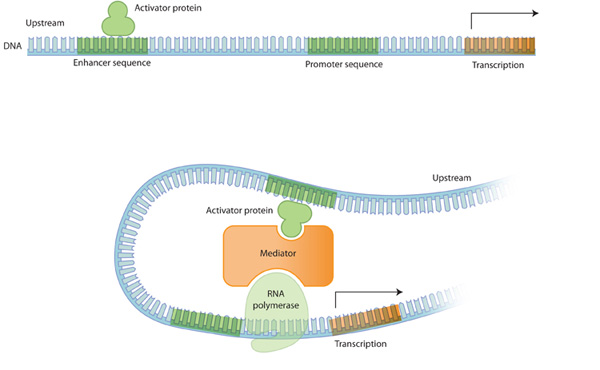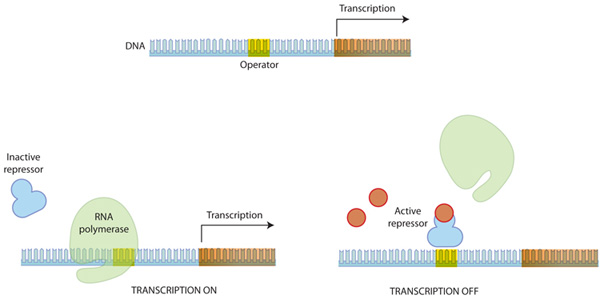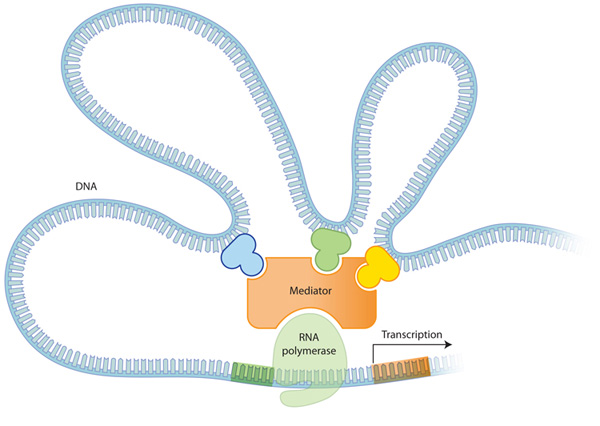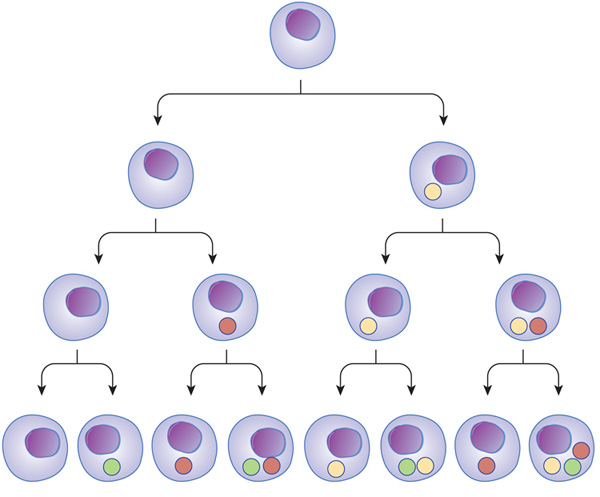유전자 발현 조절 : 유전자는 어떻게 세포의 기능을 결정하는가?
유전자 발현
인간의 DNA 속 기능의 단위인 유전자는 단백질을 암호화하고 있고, 유전자가 암호화하고 있는 단백질은 세포의 기능을 결정합니다. 따라서 어떤 세포 안에서 생성되는 수천개의 유전자는 그 세포가 무엇을 할지를 결정합니다. 각각의 세포는 다른 유전자를 생성함으로써 다른 기능을 수행하는 것입니다. 유전자 발현이란 이렇게 DNA가 최종 생산물인 단백질(혹은 ncRNA)을 생성하는 과정을 뜻합니다. 그리고 유전자 발현은 각각의 세포마다 다르게 일어납니다. 예를 들어, 시세포, 지방세포, 뇌세포 등은 각각 다른 단백질을 생성함으로써 원하는 생물학적 기능을 수행하게 됩니다. Central Dogma라고 불리는 DNA가 전사 되어 RNA가 되고 RNA가 번역되어 단백질이 되는 각각의 단계는 생성되는 단백질의 종류와 양을 조절할 수 있는 조절 포인트입니다.
어떻게 유전자 발현이 조절될까?
이처럼 유전자가 단백질이 되어가는 과정 속에서 유전자의 발현을 조절하여 유전자의 산물(전사체 혹은 단백질)의 양을 조절하는 것을 유전자 조절(gene regulation)이라고 합니다. 세포 내에서의 각 유전자들의 발현량 그 세포의 기능을 결정합니다. 유전자 조절은 여러 단계가 있지만, 그 중 전사 조절이 가장 중요하고 대부분의 유전자 조절이 일어나는 단계입니다. 사실 진핵 생물의 유전자 발현 조절은 매우 복잡합니다. 진핵생물에서는 전사체가 핵을 떠나기 전에 변형이 일어납니다. 단백질을 코딩하지 않는 부분인 "인트론"이 사라지며, 단백질을 코딩하는 부분인 "엑손" 만 남게 됩니다. 이 엑손이 서로 붙게되어 mature mRNA가 생성됩니다. 또 양 끝부분에도 변형이 일어나는데 이는 안정성에 영향을 끼칩니다. 이러한 RNA Processing의 과정 속에서도 유전자 조절이 일어날 수 있습니다. 또는 번역 단계에서도 miRNA 등의 small RNA에 의해 유전자 조절이 이루어지기도 합니다.
 Figure 1: 진핵생물에서 DNA가 단백질이 되어가는 과정
Figure 1: 진핵생물에서 DNA가 단백질이 되어가는 과정
어떻게 세포는 자신들이 필요한 유전자를 발현 시킬까?
위에서는 유전자가 단백질로 변화하는 과정 속에서 유전자 조절이 언제 이루어지는지 알아보았습니다. 그렇다면 구체적으로 어떻게 세포는 원하는 유전자만 발현시켜 원하는 기능을 수행할 수 있을까요? 이는 각각의 세포들이 제각기 다른 전사 조절 인자들을 갖고 있기 때문입니다. 이러한 조절 인자들은 전사를 촉진(activate)시키기도 하고 방해(repress)하기도 합니다. 전사 조절 인자는 단백질이며, 이 전사조절인자도 유전자들이 코딩하고 있습니다.
일반적으로 전사는 RNA 중합효소가 소위말하는 프로모터 시퀀스에 결합함으로써 시작됩니다. 이 시퀀스는 전사 시작 지점에 근접한 upstream 방향에 존재합니다. (5' 쪽 방향) 하지만 downstream 방향에도 존재할 수 있습니다. (3' 쪽 방향) 비교적 최근에 연구자들은 인핸서 시퀀스라는 것을 발견하였습니다. 인핸서는 전사 조절 단백질들이 결합할 수 있는 결합 위치(binding site)를 제공함으로써 전사에서 중요한 역할을 하는 시퀀스입니다. 이 인핸서의 전사 조절 단백질이 붙게되면 염색질 구조가 변화되어 RNA 중합효소나 조절 단백질의 결합을 촉진하거나 억제하는 역할을 하게됩니다. 이 때 염색질 구조를 open chromatin structure라고 하는데, 이는 유전자 전사가 활성화 된다는 것과 연관이 있습니다. 반면 염색질의 구조가 빽빽한 경우, 전사가 억제되어 있는 것과 연관이 있습니다.
몇몇 조절 단백질은 다양한 유전자의 전사에 영향을 미칩니다. 이는 전사 조절 단백질 결합 위치 (regulatory protein binding site 혹은 transcription factor binding site라고도 함)가 다양한 곳에 존재하기 때문입니다. 결과적으로 조절 단백질은 다양한 유전자의 걸쳐 다양한 역할을 합니다. 조절 단백질의 역할은 단지 어떤 한 유전자의 발현을 조절하는 것이 아니라 다양한 유전자의 발현을 조절합니다. 이것이 각각의 세포가 한 번에 많은 수의 유전자를 조절할 수 있는 하나의 메커니즘입니다.

우선 원핵 세포에 대해서 알아보면, 원핵생물에서 조절 단백질은 종종 영양소의 이용가능성에 의해 조절됩니다. 이는 박테리아와 같은 생물이 환경 조건에 반응하여 전사 패턴을 빠르게 조절할 수 있게 합니다. 덧붙여, 원핵생물의 조절 부위는 프로모터와 가깝게 위치합니다.

활성자(activator)는 프로모터 주위에 조절 부위에 결합하여 RNA 중합효소의 활동을 촉진합니다. 억제자(repressor)는 조절부위에 결합하여 RNA 중합효소의 결합을 방해합니다.

다른 세포 유형은 특징적인 전사 조절인자를 갖고 있습니다. 다세포 생물에서 다른 세포는 각각 다른 조절 인자들의 조합을 갖고 있습니다. 이로인해 각기 다른 기능을 하는 다양한 세포가 생성되고, 기능할 수 있는 것입니다.

참고 : Nature Education Gene expression